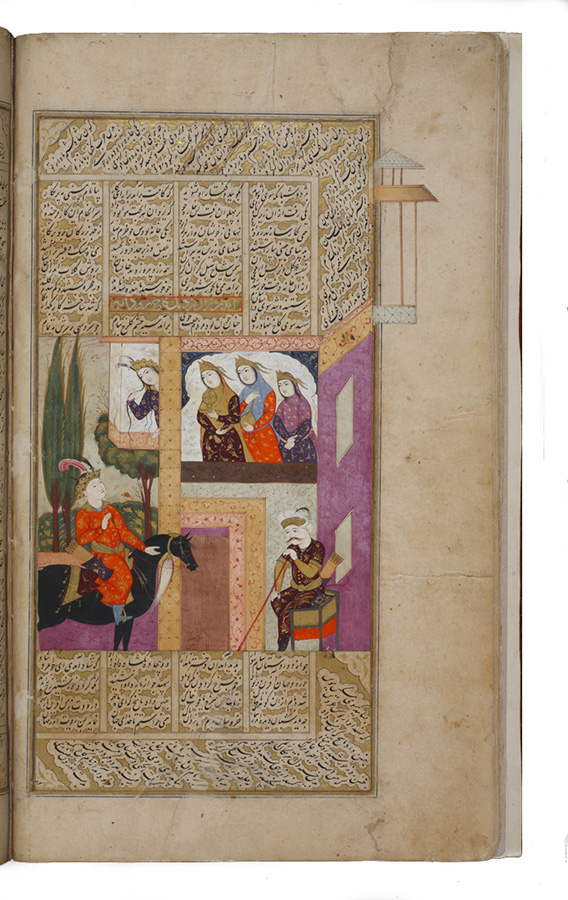Manuscript B, no. 1-270 (David folio 24b)
Zāl Comes to Rudāba's Palace and Sees Her on the Roof
Location: The David Collection, Copenhagen, Denmark, #217/2006, folio 24b.
Page: 35.2 x 21.8 cm.
Painting: 15.3 x 14.0 cm. (Scaled) without extension top right into the margin
Text area: 28.7 x 14.0 cm. (Scaled)
Signature in the center bottom edge of the painting: raqam-e kamina moʿin-e moṣavver.
Zāl, the ruler of Zabul, learned of Rudāba, the beautiful daughter of his tributary, the king of Kabul, and after enlisting the help of her handmaidens, came to her palace. Here she has loosed her long, musk-scented locks, which the Shahnama says reached the ground from her balcony. Zāl chose to send up a lasso of his own and climb it to her chamber. Although a gatekeeper sits beside the door to the palace, he appears unaware of Zāl's conversation with his charge. Meanwhile, the handmaidens stand in an upper chamber with wine and incense, ready to greet the lover of their mistress.
This composition, with a prince on horseback conversing with a princess on a balcony or second-storey terrace of a palace, has a long history in Persian painting. Early 15th-century images of Ḵosrow at Širin's palace from the Khamsa of Nezami were copied and adapted to other manuscripts such as the Shahnama through the 15th and 16th centuries. Moʿin has included trees and other vegetation here, not only to suggest the landscape outside the palace, but also to echo the description of Rudāba as "A cypress over which the full moon shone" (fn 28). The balcony extending into the right-hand margin may be unfinished and serves no pictorial purpose. Nonetheless, this is one of Moʿin's favorite architectural elements, found in many of his illustrations.
Another version of this illustration from a mid-17th-century manuscript produced in Isfahan (fn 29) contains many of the same elements: the gatekeeper, the handmaidens, and other servants, but Zāl is greeted at the door by a duenna rather than preparing to climb up a rope to Rudāba's chamber. The style of the Isfahan miniature conforms to that of the Windsor Shahnama (fn 30) a style that was in favor at the court of Shah ʿĀbbās II and at the courts of the most powerful figures in his government. However, despite its reference to an archaic rendering of the prince at the palace of his beloved, Moʿin's painting depicts the story less ambiguously than its fashionable Isfahan counterpart.
Painting references:
Canby_ Journal_2010, p.62 no.3 and p.85, fig.17.
Text references:
Warner, I, pp.270.
Photo: Permille Klemp. Courtesy of The David Collection, Copenhagen
Sheila R. Canby
Last Updated: January 5, 2014 | Originally published: 2010
